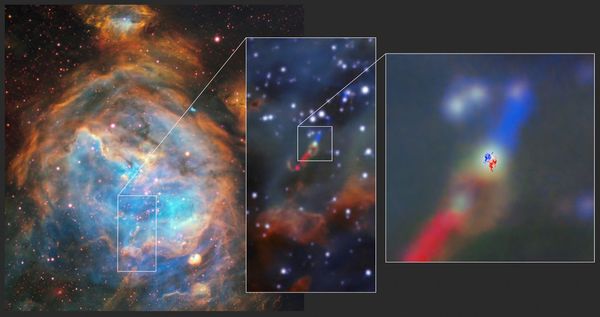
Astronomers have made an extraordinary discovery. For the first time, they have identified a young star located outside our Milky Way galaxy that is surrounded by a dense disk where planets could potentially form. This incredible find was made in the Large Magellanic Cloud, a neighboring dwarf galaxy situated about 160,000 light-years away. This groundbreaking observation offers a unique opportunity for scientists to gain a deeper understanding of the formation of stars and planets.
Newborn stars grow by pulling in matter from their surroundings. This matter gathers in a flat disk known as an accretion disk, due to the strong gravitational forces at play. The spinning disk transports the matter onto the star, causing it to grow larger over time. The more massive the star becomes, the stronger its gravitational pull, drawing in even more gas and dust into the disk.
A star as colossal as HH 1177 lives a fast and furious life, forming at an accelerated rate and having a significantly shorter lifespan compared to stars like our sun. This rapid timeline makes it challenging to observe the early stages of such massive stars within our own galaxy. The star and its disk are hidden from view by the dusty material from which they are formed.
However, this is not the case with HH 1177, which resides within a stellar nursery called N180 in the Large Magellanic Cloud. This region has relatively less dust and lower metal abundance, allowing for a clear view of the star. Lead study author Dr. Anna McLeod, an associate professor of physics at Durham University in the United Kingdom, expressed her excitement, stating, “When I first saw evidence for a rotating structure in the ALMA data, I could not believe that we had detected the first extragalactic accretion disk. It was a special moment. We know disks are vital to forming stars and planets in our galaxy, and here, for the first time, we’re seeing direct evidence for this in another galaxy.”
The Atacama Large Millimeter/submillimeter Array of telescopes in Chile, also known as ALMA, was used to detect this star. With ALMA’s precision, the astronomers were able to determine that HH 1177 is estimated to be about 15 times the mass of our sun. The findings of this remarkable discovery were published in the journal Nature.
Insights into the Dynamic Activity of a Young Star
The ALMA observations were complemented by a previous detection made with the European Southern Observatory’s Very Large Telescope. This earlier observation, using the Multi Unit Spectroscopic Explorer (MUSE) instrument, captured a powerful jet of material emanating from the young star. The star, HH 1177, was found deep within a gas cloud of the galaxy.
To confirm the presence of a disk around HH 1177, the team needed to measure the speed at which dense gas moved around the star. By observing the frequency of light emitted by the gas, they were able to determine the velocity of the gas toward or away from us. This phenomenon is similar to how the sound of an ambulance changes pitch as it approaches and then passes by. The ALMA observations provided detailed measurements of the disk’s rotation.
It is important to note that young stars are not the only celestial objects with accretion disks. Supermassive black holes also possess thin, hot disks of matter swirling around them, which they use as a source of sustenance. Dr. McLeod enthusiastically shared, “We are in an era of rapid technological advancement when it comes to astronomical facilities. Being able to study how stars form at such incredible distances and in a different galaxy is very exciting.”

In summary, the detection of a young star with a planet-forming disk in a distant galaxy has provided astronomers with invaluable insights into the universe’s fascinating processes of star and planet formation. This incredible discovery opens up new frontiers in our understanding of the cosmos and fuels our curiosity about the mysteries that await us beyond the confines of our Milky Way.




